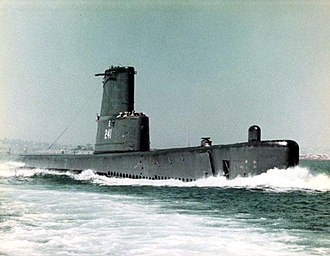1951–1969
Bashaw was recommissioned on 3 April 1951 and operated from San Diego, California, along the United States West Coast in local operations and training until 10 May 1952. She then was placed out of commission in reserve at Hunters Point Naval Shipyard in San Francisco, California, where from May 1952 to March 1953, she underwent conversion to a Type IT anti-submarine "hunter-killer submarine". Accordingly, she was reclassified SSK-241 on 18 February 1953.
After the completion of her conversion, Bashaw was recommissioned on 28 March 1953 and reported to Submarine Division 33 (SubDiv 33) at San Diego. From March to August 1954, she made a Far Eastern cruise. During 1955, she took part in several submarine exercises, including one major exercise in the Hawaiian Islands area, before beginning an overhaul at Hunters Point on 28 June 1955.
When her overhaul was completed five months later, Bashaw was ordered to her new home port, Pearl Harbor, Hawaii. There she commenced a career of providing training services to antisubmarine warfare forces, deploying to the Far East as operational needs arose and participating in fleet exercises for readiness training. From January to August 1956, she conducted her second post-World War II tour of the Far East, completing it on 14 August 1956 with her arrival at the Submarine Base, Pearl Harbor.
Lieutenant Don Walsh relinquished command of Bashaw in 1959 to serve aboard the bathyscaphe Trieste . [9] In January 1960, Walsh and Jacques Piccard made a record descent in Trieste to the bottom of the Challenger Deep, the deepest known point of the seabed of Earth. [9]
Bashaw reverted to her original designation, SS-241, in August 1959. She was redesignated as an auxiliary submarine, AGSS-241, on 1 September 1962. In October 1962, she ended a lengthy transpacific training cruise with her arrival at the 1962 World's Fair in Seattle, Washington. She returned to Hawaii to enter the Pearl Harbor Naval Shipyard in April 1963 for a four-month overhaul.
Bashaw deployed to the Western Pacific in August 1964 after the Gulf of Tonkin incident, in which North Vietnamese Navy torpedo boats confronted the U.S. Navy destroyers USS Maddox (DD-731) on 2 August and may have confronted the destroyer USS Turner Joy (DD-951) on 4 August. Bashaw was one of several submarines alerted for support during retaliatory air strikes on North Vietnam by U.S. forces, but she ended the cruise in October 1964 without incident.
Bashaw′s home port reverted to San Diego, but she continued to deploy to the western Pacific in 1965. She patrolled in the Gulf of Tonkin as the American involvement in the Vietnam War escalated. Upon her return to San Diego on 21 December 1965, she resumed antisubmarine warfare training operations until she entered the Hunters Point Naval Shipyard on 16 May 1966 for a four-month overhaul.
Bashaw continued her routine of western Pacific deployments alternating with antisubmarine warfare training until the results of an operations readiness inspection on 3 July 1969 determined that she was too old to continue naval service.
